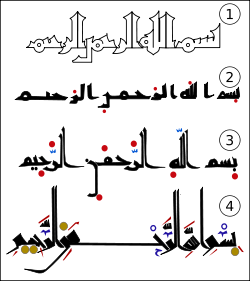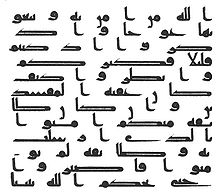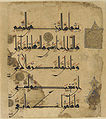- Arabic diacritics
-
"Fatha" redirects here. For the jazz pianist, see Earl Hines.
Arabic alphabet ا ب ت ث ج ح خ د ذ ر ز س ش ص ض ط ظ ع غ ف ق ك ل م ن ه و ي History · Transliteration
Diacritics · Hamza ء
Numerals · NumerationThe Arabic script has numerous diacritics, including ijam ⟨إعجام⟩ (ʾiʿǧām, consonant pointing), and tashkil ⟨تشكيل⟩ (taškīl, supplementary diacritics). The latter include the ḥarakāt ⟨حركات⟩ (vowel marks; singular: ḥarakah ⟨حركة⟩).
The Arabic script is an impure abjad, where short consonants and long vowels are represented by letters but short vowels and consonant length are not generally indicated in writing. Taškīl is optional to represent missing vowels and consonant length. Modern Arabic is nearly always written with consonant pointing, but occasionally unpointed texts are still seen. Early texts such as the Qur'an were initially written without pointing, and pointing was added later to determine the expected readings and interpretations.
Contents
Tashkil (marks used as phonetic guides)
The literal meaning of taškīl is "forming". As the normal Arabic text does not provide enough information about the correct pronunciation, the main purpose of taškīl (and ḥarakāt) is to provide a phonetic guide or a phonetic aid; i.e. show the correct pronunciation. It serves the same purpose as furigana (also called "ruby") in Japanese or pinyin or zhuyin in Mandarin Chinese for children who are learning to read or foreign learners.
The bulk of Arabic script is written without ḥarakāt (or short vowels). However, they are commonly used in some religious texts that demand strict adherence to pronunciation rules such as Qur'an ⟨القرآن⟩ (al-qurʾān). It is not uncommon to add ḥarakāt to Hadith ⟨الحديث⟩ (al-ḥadīṯ; plural: ʾaḥādīṯ) as well. Another use is in children's literature. Harakat are also used in ordinary texts when an ambiguity of pronunciation might arise. Vowelled Arabic dictionaries provide information about the correct pronunciation to both native and foreign Arabic speakers.
Short vowels can be included in cases where readers could not easily resolve word ambiguity from context alone, or simply wherever their writing might be considered aesthetically pleasing.
An example of a fully vocalised (vowelised or vowelled) Arabic from the Qur'ān (Al-Fatiha 1:1):
- ⟨ بِسْمِ ٱللهِ ٱلرَّحْمٰنِ الرَّحِيمِ ⟩
- bismi llāhi r-raḥmāni r-raḥīmi
- In the Name of Allāh, the Most Gracious, the Most Merciful
Some Arabic textbooks for foreigners now use ḥarakāt as a phonetic guide to make learning reading Arabic easier. The other method used in textbooks is phonetic romanisation of unvocalised texts. Fully vocalised Arabic texts (i.e. Arabic texts with ḥarakāt/diacritics) are sought after by learners of Arabic. Some online bilingual dictionaries also provide ḥarakāt as a phonetic guide similarly to English dictionaries providing transcription.
Harakat (short vowel marks)
The ḥarakāt, which literally means "motions", are the short vowel marks. There is some ambiguity as to which taškīl are also ḥarakāt; the tanwīn, for example, are markers for both vowels and consonants.
Fatḥah
ـَThe fatḥah ⟨فتحة⟩ is a small diagonal line placed above a letter, and represents a short /a/. The word fatḥa itself (فتحة) means opening, and refers to the opening of the mouth when producing an /a/. Example with dāl (henceforth, the base consonant in the following examples): ⟨دَ⟩ /da/.
A fatḥa followed by an ⟨ا⟩ (ʾalif) indicate a long /aː/. Example: ⟨دَا⟩ /daː/. The fatḥah is not usually written in such cases.
Kasrah
ـِA similar diagonal line below a letter is called a kasrah ⟨كسرة⟩ and designates a short /i/. Example: ⟨دِ⟩ /di/.
A kasrah plus a following letter ⟨ﻱ⟩ (yāʾ) indicate a long /iː/ (as in the English word "steed"). Example: ⟨دِي⟩ /diː/ (kasrah) is usually not written in such cases but if yāʾ is pronounced as a diphthong /aj/; fatḥah should be written on the preceding consonant to avoid mispronunciation. The word kasrah means "breaking".
Dammah
ـُThe ḍammah ⟨ضمة⟩ is a small curl-like diacritic placed above a letter to represent a short /u/. Example: ⟨دُ⟩ /du/.
And the ḍammah with a following letter ⟨و⟩ (wāw) designates a long /uː/ (as in the English word "blue"). Example: ⟨دُو⟩ /duː/. Ḍammah is usually not written in such cases but if wāw is pronounced as a diphthong /aw/; fatḥah should be written on the preceding consonant to avoid mispronunciation.
Maddah
آThe maddah ⟨مدة⟩ is a tilde-like diacritic which can appear only on top of an ʾalif and indicates a glottal stop followed by long /aː/.
The sequence /ʔaː/ should logically be spelled with a hamza on an ʾalif (representing the /ʔ/) followed by anotherʾalif (representing the /aː/) but two consecutive ʾalifs, including the combination *⟨أَا⟩, is never written. The sequence /ʔaː/ must always be written with an ʾalif maddah. Example: ⟨ﺁ⟩.
Dagger alif
ــٰThe superscript (or dagger) ʾalif ⟨ألف خنجرية⟩ (ʾalif ḫanǧariyyah), is written as short vertical stroke on top of a consonant. It indicates a long /aː/ sound where ʾalif is normally not written, e.g. ⟨هٰذَا⟩ (hāḏah) or ⟨رَحْمٰن⟩ (raḥmān).
The dagger ʾalif occurs in only a few words, but these include some common ones; it is seldom written, however, even in fully vocalised texts. Most keyboards do not have dagger ʾalif. The word Allah ⟨الله⟩ (Allāh) is usually produced automatically by entering ʾalif lām lām hāʾ. The word consists of ʾalif + ligature of doubled lām with a šaddah and a dagger ʾalif above ʾlām.
Alif waslah
ٱThe waṣlah ⟨وصلة⟩, ʾalif waṣlah ⟨ألف وصلة⟩ or hamzat waṣl ⟨همزة وصل⟩ looks like a small letter ṣād on top of an ʾalif ⟨ٱ⟩ (also indicated by an ʾalif ⟨ا⟩ without a hamzah). It means that the ʾalif is not pronounced, e.g. ⟨بٱسم⟩.
It only occurs in the beginning of words (can occur after prepositions and the definite article). It is commonly found in imperative verbs, the perfective aspect of verb stems VII to X and their verbal nouns (maṣdar). The alif of the definite article is considered a waṣlah.
Sukun
ـْـThe sukūn ⟨سكون⟩ is a circle-shaped diacritic placed above a letter. It indicates that the consonant to which it is attached is not followed by a vowel; this is a necessary symbol for writing consonant-vowel-consonant syllables, which are very common in Arabic. Example: ⟨دَدْ⟩ dad.
The sukūn may also be used to help represent a diphthong. A fatḥah followed by the letter ⟨ﻱ⟩ (yāʾ) with a sukūn over it indicates the diphthong ay (IPA /aj/). A fatḥah followed by the letter ⟨ﻭ⟩ (wāw) with a sukūn indicates /aw/.
Tanwin (final postnasalized or long vowels)
Main article: Nunationـٌ ـٍ ـًThe three vowel diacritics may be doubled at the end of a word to indicate that the vowel is followed by the consonant n. These may or may not be considered ḥarakāt, and are known as tanwīn ⟨تنوين⟩, or nunation. The signs indicate, from right to left, -un, -in, -an.
These endings are used as non-pausal grammatical indefinite case endings in literary Arabic or classical Arabic (triptotes only). In a vocalised text, they may be written even if they are not pronounced (see pausa). See ʾiʿrāb for more details. In many spoken Arabic dialects, these endings are absent. Many Arabic textbooks introduce standard Arabic without these endings. The grammatical endings may not be written in some vocalized Arabic texts, as knowledge of ʾiʿrāb varies from country to country, and there is a trend in simplifying the Arabic grammar.
The sign ⟨ـً⟩ is most commonly written in combination with ⟨ـًا⟩ (ʾalif), ⟨ةً⟩ (tāʾ marbūṭah) or stand-alone ⟨ءً⟩ (hamzah). ʾAlif should always be written (except for words ending in tāʾ marbūṭah, hamzah or diptotes), even if an is not. Grammar cases and tanwīn endings in indefinite triptote forms:
- -un: nominative case;
- -an: accusative case, also serves as an adverbial marker;
- -in: genitive case.
Shaddah (consonant gemination mark)
Main article: ShaddaـّـThe shadda or shaddah ⟨شدة⟩ (šaddah), or tashdid ⟨تشديد⟩ (tašdīd), is a diacritic shaped like a small written Latin "w".
It is used to indicate gemination (consonant doubling or extra length), which is phonemic in Arabic. It is written above the consonant which is to be doubled. It is the only ḥarakah that is sometimes used in ordinary spelling to avoid ambiguity. Example: ⟨دّ⟩ /dd/; madrasah ⟨مدرسة⟩ ("school") vs. mudarrisah ⟨مدرّسة⟩ ("teacher", female).
Ijam (phonetic distinctions of consonants)
The ijam ⟨إعجام⟩ (ʾiʿǧām) are the pointing diacritics that distinguish various consonants that have the same form (rasm), such as ⟨ـبـ⟩ /b/, ⟨ـتـ⟩ /t/, ⟨ـثـ⟩ /θ/, ⟨ـنـ⟩ /n/, and ⟨ـيـ⟩ /j/. Typically ijam are not considered diacritics but part of the letter.
Early manuscripts of the Qurʾān did not use diacritics either for vowels or to distinguish the different values of the rasm. Vowel pointing was introduced first, as a red dot placed above, below, or beside the rasm, and later consonant pointing was introduced, as thin, short black single or multiple dashes placed above or below the rasm (image). These ijam became black dots about the same time as the ḥarakat became small black letters or strokes.
Typically, Egyptians do not use dots under final yāʾ ⟨ي⟩, both in handwriting and in print, as ʾalif maqṣūrah ⟨ى⟩. This practice is also used in copies of the muṣḥaf (Qurʾān) scribed by ʿUṯman Ṭāhah. The same unification of yāʾ and ʾalif maqṣūrā has happened in Persian, resulting in what The Unicode Standard calls "arabic letter farsi yeh", that looks exactly the same as yāʾ in initial and medial forms, but exactly the same as ʾalif maqṣūrā in final and isolated forms ⟨یـ ـیـ ـی⟩.
Hamza (glottal stop semi-consonant)
Main article: Hamzaئ ؤ إ أAlthough often a diacritic is not considered a letter of the alphabet, the hamza همزة (hamzah, glottal stop), often does stand as a separate letter in writing, is written in unpointed texts, and is not considered a taškīl. It may appear as a letter by itself or as a diacritic over or under an ʾalif, wāw, or yāʾ.
Which letter is to be used to support the hamzah depends on the quality of the adjacent vowels.
- If the syllable occurs at the beginning of the word, the glottal stop is always indicated by hamza on an ʾalif.
- But if the syllable occurs in the middle of the word, ʾalif is used only if it is not preceded or followed by /i/ or /u/.
- If /i(ː)/ is before or after the glottal stop, a yāʾ with a hamzah is used (the two dots which are usually beneath the yāʾ disappear in this case: ⟨ئ⟩).
- If [u(ː)] is there, a wāw sukūn with a hamzah is used.
Consider the following words: ⟨أَخ⟩ /ʔax/ ("brother"), ⟨إِسْرَائِيل⟩ /ʔisraːʔiːl/ ("Israel"), ⟨أُمْ⟩ /ʔumm/ ("mother"). All three of above words "begin" with a vowel opening the syllable, and in each case, ʾalif is used to designate the initial glottal stop (the actual beginning). But if we consider middle syllables "beginning" with a vowel: ⟨نَشْأة⟩ /naʃʔa/ ("origin"), ⟨إِسْرَائِيل⟩ /ʔisraːʔiːl/ ("Israel" — notice the /ʔiːl/ syllable), ⟨رَؤُوف⟩ or ⟨رَءُوف⟩ /raʔuːf/ ("lenient"), the situation is different, as noted above. See the comprehensive article on hamzah for more details.
History
 Evolution of early Arabic calligraphy (9th – 11th century). The Basmala was taken as an example, from kufic Qurʾan manuscripts.
Evolution of early Arabic calligraphy (9th – 11th century). The Basmala was taken as an example, from kufic Qurʾan manuscripts.
(1) Early 9th century, script with no dots or diacritic marks (see image of early Baslama Kufic);
(2) and (3) 9th – 10th century under Abbasid dynasty, the Abu al-Aswad’s system establish red dots with each arrangement or position indicating a different short vowel; later, a second black dots system was used to differentiate between letters like fāʾ and qāf (see image of middle Kufic);
(4) 11th century, in Al Farāhídi’s system (system we know today) dots were changed into shapes resembling the letters to transcribe the corresponding long vowels (see image of modern Kufic in Qur'an).According to tradition, the first to commission a system of harakat was Muawiyah I of the Umayyad dynasty, when he ordered Ziad Ibn Abih, his wāli in Basra (governed 664–673), to find someone who would devise a method to transcribe correct reading. Ziad Ibn Abih, in turn, appointed Abu al-Aswad al-Du'ali for the task. Abu al-Aswad devised a system of dots to signal the three short vowels (along with their respective allophones) of Arabic. This system of dots predates the ʾiʿǧām, dots used to distinguish between different consonants.
Abu al-Aswad's system
Abu al-Aswad's system of Harakat was different from the system we know today. The system used red dots with each arrangement or position indicating a different short vowel.
A dot above a letter indicated the vowel a, a dot below indicated the vowel i, a dot on the side of a letter stood for the vowel u, and two dots stood for the tanwīn.
However, the early manuscripts of the Qur'an did not use the vowel signs for every letter requiring them, but only for letters where they were necessary for a correct reading.
Al Farahidi's system
This is the precursor to the system we know today. Al-Farāhīdī found that the task of writing using two different colours was tedious and impractical. Another complication was that the ʾiʿǧām had been introduced by then, which, while they were short strokes rather than the round dots seen today, meant that without a color distinction the two could become confused.
Accordingly he changed the harakat into shapes looking like the letters used to transcribe the corresponding long vowels. His system evolved to the system we know today.[citation needed]
See also
- Arabic alphabet:
- Niqqud, the Hebrew equivalent of ḥarakāt
- Dagesh, the Hebrew diacritic similar to Arabic ʾiʿǧām and shaddah
- Furigana, a phonetic guide for Japanese
- Pinyin and Bopomofo, phonetic guides for Chinese
References
External links
- Online Arabic Diacritic Tool
- Free Comprehensive Reference of Arabic Grammar
- Basic Introduction To Arabic Short Vowels
- Vocalised Arabic (and other) texts online (for children)
- Fully vocalised, transliterated and translated online Qur'ān with audio
- Sakhr Multilingual Dictionary (uses Harakat)
- web-based Arabic Notepad that supports full vowelization (tashkiil)
- Google Arabic Diacritic Tool “Tashkeel”
Arabic · العربية Overviews 
Alphabet Letters Eras Notable varieties Standardized: Modern Standard Arabic, Regional: Egyptian · Iraqi · Levantine · Maghrebi · Sudanese · Arabian · Judeo-ArabicAcademic Calligraphy
and scriptsLinguistics Phonology · Sun and moon letters · ʾIʿrāb (inflection) · Grammar · Triliteral root · Mater lectionis · IPA · Quranic Arabic CorpusCategories:- Arabic diacritics
- Arabic words and phrases
- Quranic orthography
- Phonetic guides
Wikimedia Foundation. 2010.



